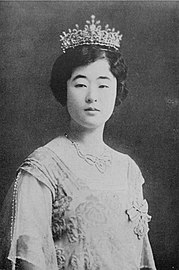Bangja Yi's Human Design Chart
4/6 Sacral Generator**Bangja Yi: A Life of Royalty and Service Through the Lens of Human Design**
Born as Princess Masako Nashimoto on November 4, 1901, in Tokyo, Japan, Bangja Yi was a remarkable figure who embodied the dual heritage of Japanese and Korean royalty. As the first daughter of Prince Nashimoto Morimasa, she was initially considered a leading candidate to marry the future Emperor Hirohito. However, due to concerns regarding her family’s political influence and potential fertility issues, she was ultimately removed from consideration. Instead, she was chosen to wed Crown Prince Euimin of Korea, who had been held by the Japanese government under the guise of studying abroad. Their wedding took place on April 28, 1920, at the Korean King’s Palace in Tokyo, where she assumed the title of Her Royal Highness Bangja, Crown Princess Euimin.
Despite facing an initial unfavorable fertility diagnosis, Bangja Yi gave birth to a son, Prince Jin, on August 18, 1921. Tragically, he died under mysterious circumstances less than a year later. Following the death of Emperor Sunjong in 1926, she received the formal title of Her Majesty Queen Lee, although the political landscape shifted her title back to Crown Princess due to the Japan-Korea Annexation Treaty.
As a Generator in Human Design, Bangja Yi’s life was characterized by her ability to respond to the needs around her, guided by her Sacral Authority. This innate capacity to respond played a crucial role in her dedication to humanitarian efforts, particularly in the education and support of mentally and physically handicapped individuals. She founded the Jahye School and the Myeonghye School, which aimed to help these individuals adapt socially, earning her the affectionate title of “the mother of the handicapped in Korea.”
With a Profile of 4/6, Bangja Yi exemplified the qualities of a networker and a role model. The 4th line reflects her ability to build connections and create a supportive community, while the 6th line signifies her journey toward wisdom, having experienced both the highs and lows of life. Her channels, particularly the 15-5, highlight her unique expression of individuality and her capacity to inspire others through her authentic self. Furthermore, her Incarnation Cross, the Right Angle Cross of The Four Ways (44/24 | 33/19), emphasizes her purpose of exploring diverse paths and sharing her insights with others.
Despite the challenges she faced, including the lingering anti-Japanese sentiment in Korea, Bangja Yi was widely respected for her contributions to society. After World War II, she and her family lived in Japan until they returned to Korea in 1963 at the invitation of President Park Chung-hee. During this time, she continued her advocacy work, leading various committees and initiatives to support those in need.
Bangja Yi passed away on April 30, 1989, at the age of 87 in Nakseon Hall, Changdeok Palace, leaving behind a legacy of compassion and resilience. Her life story is not only a testament to her royal lineage but also an inspiring example of how one can respond to life’s challenges with grace and a dedication to service, perfectly reflecting her Generator nature in Human Design.
Discover More Famous People
Browse and analyze over 55,000 public figures and celebrities.
Ra Uru Hu
5/1 Manifestor
Martha Stewart
4/6 Manifestor
David Lynch
4/6 Generator
Barack Obama
6/2 Projector
Steve Jobs
6/3 Generator
Vladimir Putin
5/1 Manifestor
Kim Kardashian
3/5 Generator
Michael Jackson
1/3 Projector
Marilyn Monroe
6/2 Projector
Ariana Grande
2/4 Projector
Oprah Winfrey
2/4 Generator
Johnny Depp
2/4 ManifestorWhat is HumanDesign.ai and how does it work?
Curious what makes Bangja Yi tick? HumanDesign.ai instantly maps their exact birth data into a fully interactive clickable bodygraph chart, letting you hover or tap every center, channel, and gate for plain-language explanations. Bella, the platform’s built-in AI guide, adds context in real time, translating complex mechanics into everyday insights so you can see how Bangja Yi’s strengths, challenges, and life themes play out on-screen.
The same tools are waiting for you. Generate your own Human Design Chart in seconds, open a library of 2000+ suggested questions, and chat with Bella as often as you like to decode your design, daily transits, and even relationship dynamics.
Want to compare energies? Save unlimited charts for friends, family, or clients, then ask Bella to reveal compatibilities, composite patterns, or coaching tips, all in one conversation thread.
Start free with core features, or unlock our Personal and Pro plans for deeper dives: unlimited Q&A, celebrity chart search spanning 55,000+ public figures, white-label PDF reports, branded content generation, and a professional profile with built-in booking for practitioners. Whether you’re exploring your own potential or guiding others, HumanDesign.ai delivers an ever-expanding toolbox of AI-powered insights—no spreadsheets, no jargon, just clarity at your fingertips.
Ready to see yours? Signup for FREE today!

